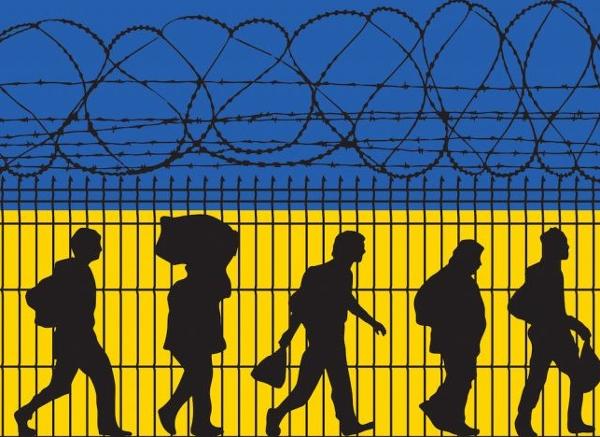Since the beginning of the Russian war against Ukraine and as of 18 March 2022, more than 3.2 million people have left the country, seeking refuge mainly in EU neighboring States, such as Poland, Romania, and Hungary. The EU is expecting to receive up to 6.5 million people, thus potentially compromising the functioning of national asylum and reception systems of the EU Member States exposed to massive conflict-driven inflows. For these reasons, on 4 March 2022, the Council of the European Union decided to implement Directive 2001/55/EC on Temporary Protection for the very first time since its adoption in 2001. Indeed, temporary protection is an emergency mechanism that can be applied in cases of mass influx due to, inter alia, conflicts, systemic violence or violations of human rights to provide immediate and collective protection, i.e. bypassing the examination of individual protection claims that in a situation of emergency might not be feasible. By providing protection on a collective basis, this instrument ultimately aims to comply with the principles of non-refoulement and of non-discrimination, by ensuring a safe place to everyone in need.
For the purposes of this contribution, we will particularly focus on the latter principle, which is not only a general principle of international law and of international refugee protection, but it is also essential to define and implement the 1951 Geneva Convention on the Status of Refugees and its 1967 Protocol, which provide the cornerstone of the international legal regime for the protection of refugees. Indeed, discrimination on account of race, nationality, political opinion, religion, and membership of a particular social group is at the core of the well-founded fear of persecution. Discrimination of any kind leading to unlawful exclusion, restriction or privilege that has the effect of nullifying a particular right is forbidden under the 1948 Universal Declaration on Human Rights (articles 2 and 7). The 1951 Refugee Convention clearly states that provisions enshrined therein must be applied without discrimination as to race, religion, or country of origin (article 3). The EU legal order has embedded the principle of non-discrimination not only as a cross-cutting, underlying component of the fundamental rights of the individual in general (article 21 of the EU Charter of Fundamental Rights), but also in relation to refugees and migrants in particular, by virtue of binding all Member States to implement the Common European Asylum System in full compliance with the principle of non-discrimination.
The Council Implementing Decision (EU) 2022/382 on temporary protection of 4 March 2022, however, seems to deviate from these grounding principles of international law by creating three categories of people who, despite sharing the same cause of forced migration, 1) are automatically entitled to temporary protection; 2) may still hope to be considered for temporary protection; 3) will very unlikely be entitled to temporary protection.
Indeed, the Council decided to automatically apply temporary protection to Ukrainian citizens residing in Ukraine before 24 February 2022; international protection holders residing in Ukraine before 24 February 2022; their respective family members, including close family ties and relatives living together as part of the family unit when the war started and who are wholly or mainly dependent on the holder. Foreigners living in Ukraine with a valid permanent residence permit and who are unable to return in safe and durable conditions to their country or region of origin should also be provided with temporary protection or another adequate protection status available at the national level (article 1, paras 1-2).
The Council Decision then moves to the second category of people, whose entitlement to temporary protection is left to the discretional decision of single Member States, pursuant to article 7 of Directive 2001/55. The Member States are therefore encouraged, but not obliged, to extend temporary protection to foreigners residing in Ukraine with a valid yet short-term residence permit, for instance for job or education purposes (article 2, para. 3). Similarly, Member States are invited to consider extending temporary protection to those persons who left Ukraine not long before 24 February 2022 or who found themselves in the territory of the Union (e.g. on holidays or for work reasons) just before that date and are thus unable to return (preambular para. 14). Although the aim of the Directive and of the Council Decision is to encourage States to expand the scope of application of Temporary Protection to additional categories of people in need, the discretional power left to the Member States risks creating a boomerang effect, as it risks damaging both people fleeing the armed conflict and the EU States themselves. Indeed, the fragmented entitlement to temporary protection may lead to disproportionate flows of people belonging to this second category, who may head to those EU Member States where they will be entitled to temporary protection, thus continuing their journey across the EU instead of seeking refuge within the first EU country of entry, while exposing those Member States to increasing flows.
Finally, there is a third category that is composed of the unlisted, including international protection-seekers in Ukraine and irregular migrants, who are not mentioned in the Decision. The Member States are therefore not required to provide temporary protection to them nor are they encouraged to do so. The Council Decision does not explain the reason(s) behind this clear diversification of treatment, which seems to be based on the degree of stability and regularity of their position in Ukraine. As noted, “[t]he resulting picture is one leaving a high degree of legal uncertainty concerning the obligations of relevant Member States possessing an EU external border with Ukraine towards non-Ukrainian third country nationals, which can be expected to lead to inconsistent and potentially discriminatory national approaches”.
Despite some limitations, it is laudable that the members of the Council adopted this Decision by unanimity, showing unity and solidarity for the civilians fleeing the armed conflict as well as for the EU countries most exposed to their arrival. However, it is also important to pinpoint to previous mass migration movements triggered by civil or international conflicts that have been treated differently. Since its adoption in the aftermath of the war in ex-Yugoslavia, the Arab Springs in the Middle East and North Africa, the persisting civil wars in Syria and Afghanistan, and the instrumentalization of migrants that, despite the relatively small numbers, has been deemed to jeopardize the stability of three national asylum systems and to require an ad hoc emergency package, are all emblematic occasions in which Directive 2001/55/EC could have played a significant role in immediately protecting people from trauma, conflicts, and extreme violations of their rights, calling on States to show inter-state solidarity. Mass influx of people fleeing conflicts and systematic violations of their basic human rights perfectly fit within the scope of temporary protection, therefore the reason why EU institutions refrained from applying temporary protection in these events seems not to lie in its scope of application. An alternative reason why Directive 2001/55 has not been activated before might refer to the perception that previous numbers were not sufficiently high to reach the required threshold to qualify as “mass inflows”. However, data suggests that at the peak of the so-called refugee crisis in 2015, 1.3 million Syrians arrived in Europe and asked for international protection. In that occasion, temporary protection had not been activated, in contrast with the current crisis, where, at the time the Council implementing Decision was adopted, the number of people arriving in the EU from Ukraine was as high as 650 thousand.
As stated by Carrera et al., “[a] comparison between the EU and Member States’ responses to the large scale number of entries resulting from the Ukraine War with recent past policies and debates dealing with people fleeing conflicts in Libya, Syria or Afghanistan reveals a stark contradiction with the lack of political support by some EU Member States over the Commission and European Parliament’s proposals for reforming the EU asylum system in 2015/2016. They also show the existence of latent structural discrimination as a key factor characterizing what is ‘realistic’ or not in EU asylum and migration policies” (See also İneli Ciğer and Schultz for similar comments).
All in all, the long-due activation of the Temporary Protection Directive is undoubtedly to be applauded. As recalled by Peers, the Council decision waives many basic EU asylum requirements, “but it raises obvious questions about the double standards which apply to others fleeing war or persecution”.
In such circumstances, it is therefore crucial to recall the State’s duty, under international refugee law, to protect everybody fleeing conflicts, regardless of the individual characteristics of those who are compelled to flee and of the geographical proximity of the armed conflict. In this context and in the author’s view, the reluctance of the Union to apply temporary protection in previous cases, on the one hand, and the category-based issuance of temporary protection, on the other, risk colliding with international refugee law and with the principle of non-discrimination. As Carrera et al. conclude, the Council Decision “[…] does not seem objective, legally certain and does not apply consistent EU-wide treatment of non-Ukrainian nationals and asylum seekers fleeing Ukraine. This opens up a clear risk of discriminatory treatment during its implementation phases by Member States’ authorities”.






















